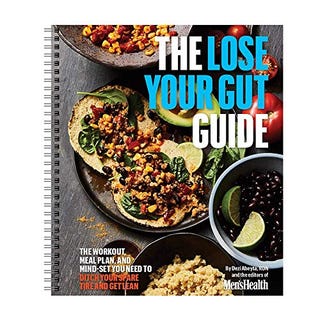There’s fat all over your body, not just between your ribcage and your waistband.
The adipose tissue that resides under your skin is a connective tissue called subcutaneous fat, and it sort of jiggles when you flick it or pinch it.
But there’s another kind of fat that’s harder to spot unless you happen to be sporting the telltale protruding belly. That tissue is called visceral fat because it forms around your viscera deep in the belly near your internal organs. It doesn’t jiggle; it’s firm to the poke.
Men are more prone to depositing fat in this abdominal danger zone than women, who tend to wear it in their butt, hips, and thighs.
Visceral fat is the worst kind of fat not only because it’s so stubborn to get rid of but because it acts like a toxic waste dump spewing harmful chemicals and influential hormones right next to your most important body parts.
These secretions can increase inflammation in your body and make insulin less effective at dealing with blood glucose from the foods you eat, putting you at greater risk for diabetes and heart disease.
Here’s more unwelcome news: Visceral belly fat reduces testosterone levels and also damages the lining of blood vessels, compromising blood flow—and you know how important both are to maintaining a strong sex drive and firm erections.
Okay, so now that you’ve had your biology lesson, let’s switch to health class because there’s a lot you can learn to do to start attacking that dangerous belly fat and slimming your middle.

But first, a little motivational exercise: Grab a tape measure and figure out your waist circumference. Take your shirt off and wrap the tape measure around your waist, slightly above your belly button and parallel with the floor. Exhale and check the measurement. The tape shouldn’t be tight. If you measure more than 40 inches (the benchmark for men), you are at greater risk for obesity-related diseases, according to the National Institutes of Health.
What’s more, an analysis of waist size and mortality in 650,000 adults published in the Mayo Clinic Proceedings determined that men with a waist circumference of 43 inches had more than a 50% greater risk of death than did men with a 37-inch waist.
If your own tape measure test sends you such a wakeup call, below are some actions you can take today to start eliminating dangerous visceral fat from your midsection.
And if you’d like to take a deeper dive to lose those holiday pounds and get back in shape, we recommend a new, comprehensive New Year-New You guide called Lose Your Gut! The 21-Day Plan to Banish Belly Fat Forever from the editors of Men’s Health.
Belly Off Step 1: Follow the Leaders
Goose your motivation and find useful tips by reading weight-loss success stories of readers like you in Men’s Health. Check out this guy who dropped 40 pounds without giving up his favorite foods. And consider these common strategies used by participants in the National Weight Control Registry, which tracks more than 10,000 people who have lost significant amounts of weight and kept it off for long periods:
- 78% eat breakfast every day.
- 75% weigh themselves at least once a week.
- 62% watch less than 10 hours of TV per week.
- 90% exercise, on average, about 1 hour per day.
Belly Off Step 2: Pack on More Muscle
What looks good under a tight T-shirt can keep belly fat at bay.

Skeletal muscle is an active tissue that plays a key role in taking up glucose from your bloodstream, burning calories and increasing your metabolism. The more you have, the more you may be protected against insulin resistance and prediabetes, both of which are strongly associated with abdominal fat.
A study in Journal of Clinical Endocrinology and Metabolism, for example, found that every increase in the ratio of skeletal muscle mass to total body weight was associated with an 11% reduction in risk of insulin resistance.

That’s why building and maintaining muscle becomes increasingly important as you age: less muscle makes weight loss more difficult and weight gain a lot easier.
“Peak muscle mass is between ages 20 and 35 and people start losing muscle in their late 30s,” says Roger Fielding, PhD, senior scientist and director of the Nutrition, Exercise Physiology and Sarcopenia Laboratory at Tufts University. “But we know that resistance exercise can have a profound effect on the quality of life and how successfully you age.”
A large study of more than 10,000 adults published in the journal Obesity demonstrated the impact of weight training on waist circumference over the course of more than a decade. The researchers from the Harvard School of Public Health found that people who spent 20 minutes a day weight training gained less abdominal fat over 12 years than people who spent the same amount of time every day performing cardio exercises.
Belly Off Step 3: Manage Your Cravings with Protein
Caving in to cravings can easily pile on the pounds if you satisfy your hunger with calorie-dense processed snacks and chips and baked goods. But being strategic about your snacks and timing them right can tamp down cravings and help you lose weight. One of the best snacks for accomplishing this is protein because it stimulates hormones that make you feel full and prolongs that feeling.

Consider this 2014 study in Nutrition Journal that compared a high-protein snack of yogurt to energy-dense, high-fat snacks of crackers and chocolate. Researchers found that participants reported much greater reductions in afternoon hunger after eating the yogurt versus when they ate the chocolate and cracker snack.
And the high-protein snack led to participants consuming around 100 fewer calories at dinner than they did after eating the high fat, high carb processed snacks.
Belly Off Step 4: Speed Up to Burn More Fat
You’ve probably heard this before, but are you doing it?

We’re talking about really pushing the limit of your cardio capacity by doing high intensity interval training (HIIT). Studies like this one in the Journal of Strength Conditioning Research have shown that you can burn up to 30% more calories doing a speedy exercise session (think running sprints) versus doing a lower-intensity steady-state workout (think walking or jogging) of the same amount of exercise time. HIIT is easy to incorporate into your weekly exercise routine.
For example, when running or cycling, simply alternate short bursts of intense all-out effort for say 20 to 30 seconds with slower and longer recovery segments of a minute or two. You’ll find that your workouts will be shorter by necessity due to the increased intensity of effort.
And you may notice your belly shrinking quicker than ever, suggests a 2018 meta-analysis of 39 studies involving 617 subjects published in Sports Medicine. The researchers reported that MRI scans showed significant visceral fat loss following the HIIT exercise interventions and concluded that “HIIT is a time-efficient strategy to decrease fat-mass deposits.”
Belly Off Step 5: Practice Diversity and Inclusion in Your Gut
You’ve got tons of bacteria crawling around in your intestines already but improving the diversity of that community of bugs in your gut is another powerful belly-slimming strategy.

“Microbiome analysis has revealed a relationship between nutrition, the gut microbiota and a number of human diseases including obesity,” writes National Institutes of Health nutritionist Cindy Davis, PhD, in the journal Nutrition Today.
She points to research suggesting that the composition of bacteria in the gut differs between lean people and those who carry a lot of abdominal fat and that diets high in fat and refined carbohydrates promote the growth of bacteria linked to obesity. One study in the Proceedings of the National Academy of Science linked low bacterial diversity with significant body fat and inflammation.
The researchers discovered that obese participants had more harmful gut microbes called Firmicutes that promote fat storage and 90% fewer Bacteroidetes, a class of bacteria that breaks down starches and fiber for immediate use as energy. You can improve your ratio of fat burning to fat storing gut bugs by eating more fiber-rich plants.
Try fermented cabbage foods like sauerkraut and kimchi, which are a terrific source of probiotics. A recent review of 20 studies involving nearly 2,000 adults in the International Journal of Food Sciences and Nutrition found that eating probiotics reduced both body weight and body mass index in overweight people. Another great way to build a more diverse environment in your gut is eating a fiber-rich Mediterranean-style diet full of vegetables and especially beans, one of the very best foods to build up your Bacteroidetes diversity.
For more belly fat-melting tips and strategies, download Lose Your Gut! The 21-Day Plan to Banish Belly Fat Forever.
Source: Read Full Article
